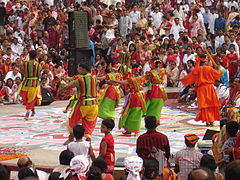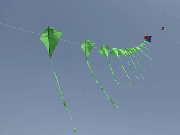India is a land of fairs and festivals. Different state celebrate different festivals in different ways. If the people of Kerala celebrate Onam with great zeal and gust, the people of Tamil Nadu celebrate Pongal in the same way. The word Pongal refers to the "boiling over" of milk and rice during the month of January. Pongal is infact the greatest and the most important festival of the people of Tamil Nadu. It is celebrated in the month of January. It continues for three days.
This festival has a special significance for farmers. The programme of celebrations is mainly connected with agriculture. In Tamil Nadu, there are rains in winter. Rice is the chief agriculture produce of the state. The rice crop needs a lot of rain water. Lord Indra is believed as the god of rain. Therefore, they worship Lord Indra is the special feature of the celebrations of Pongal festival.
The farmers of Tamil Nadu eagerly look forward to this festival. The rice crop ripens and is ready for harvesting by the end of December in the middle of January. The farmers are in a holiday mood after harvesting and hustling the paddy crop. Rice is obtained after husking the paddy. Then the farmers are free to celebrate the festival with utmost gaiety. It is a festival of joy and it is celebrated with great pomp and show.
The first day of the festival is known as Bhogi Pongal. On this day, rice gruel is prepared in almost every home in Tamil Nadu. It is a delicious dish prepared from rice. People invite friends and relatives to a feast of rice gruel.These feasts are held in honour of Lord Indra, the god of rain. It is believed that the rice crop is due to the grace and benediction of Lord Indra. Offering of rice are made to the God and it is considered auspicious to eat rice on that day. So people eat rice in various forms.
The second day of the festival is set apart for the worship of the Sun. It is called Surya Pongal. On this day the people make offerings of boiled rice to the sun. It is a day of thanks giving to the sun. It is believed that the sun plays a vital role in ripening the paddy crop. The sun god is thanked and worshiped for his favour to the farmers. So the offerings of boiled rice are made to appease the sun god. Woman prepare models of the sun on this day.
The third day of celebration is known as Matu Pongal. The farmers of Tamil Nadu regard the cow as their sacred mother and worship her. This day is dedicated to cow worship because cow plays an important in the agriculture. The cows are washed, cleaned and their horns are painted red, green and yellow. Their foreheads are decorated with mocks. They are fed on good things. At night people cook delicious dishes in their homes and invite friends and relatives to a feast.
Pongal has its own santity and religious touch. It is a festival of gratitude to the gods and animals for their help and favour in agriculture.
Introduction
Navratri lasts long for nine days in Gujarat. It is held twice in a year. One is held in the month of April and the other is held in September or October. The festival runs for nine days. Many people fast during theses nine days. Many dance, sing, pray and fast to get blessings. In many parts of India Garba and Dandiya, a traditional form of Gujarat is organized. Especially in Gujarat it is celebrated in a grand way. People gathered in the corner of the street, schools, colleges, in field and even in the club to perform Garba and Dandiya. Everyone in Gujarat become the part of this dance form. This continues nine days, ends in the eve of Dusshera, when Goddess Durga defeats the demon, and Rama killed Ravana.
Navratri the festival of nine days
As like other festival people do yajnas (sacrificial fires) in this festival no such chants are performed. People simply burst in dance and celebrate the Navratri festival. No other country celebrates this festival in a grand way as it is celebrated in Gujarat. In Gujarat it lasts for nine days and nights and people gathered and dedicated their prayers to nine avatars of Goddess Amba, which is known as the God of power. Each day people gather and perform the Garba dance. They are all dressed in colorful dresses. This beauty could not be found in other states.
People of Gujarat also participate in the drama which is called "Bhavai" is performed only by the male artists. People of Gujarat go for fasting for nine days and on the tenth day they break their fast by eating "sweet jalebi" and"fafda" a very popular dish of Gujarat. Not every moment can be describe in words. It would be better if any one visits Gujarat during Navratri and could be the eyewitness of this very beautiful festival. Therefore, visit Gujarat and be a part of this beautiful festival.
The dress and ornaments shops
On this occasion people of Gujarat, prefer to wear chaniya-choli. During the Garba, dance women wear beautiful chaniya-choli and men wear kafni pajamas with short kurta. During Navratri, most of the shops in Gujarat sell chaniya-choli. People rush to the shop to purchase the colorful and decorative chaniya-choli. Some famous shop, which sells this dress material are 'Aso Palav', 'Deepkala', 'Rupkala', 'Radhika Stores' situated in Ahmadabad, Surat and Vadodara. Men's wear could be found in the shop known as 'Jade Blue'. Bandhej chaniya-choli are also very famous. One could also purchase the complete set of dress for the Garba from the famous shop of 'Ratan Poll' situated in the city of Ahmadabad.
Many other markets such as Ajanta shopping centre and many small and large boutique stores are also famous for the Garba dress. One could also purchase the beautiful and decorative dandiya sticks from 'Ramakda Market' very near to Teen Darwaja in Ahmadabad. During Navratri, the place where the Garba and Dandiya dance are organized many food stalls are set up temporarily which are opened until midnight and people enjoy the food from the stalls.
Rhythmic dance form
On Navratri, people perform the folk dance of Gujarat. Many competitions are also organized where skilled dancers perform the folk dance. Famous folk dance includes Garba, Dandiya, Bhavai, Tippani and Hudo. These are very musical and energetic and it reflects the true color of vibrant Gujarat. Men and women look beautiful in their colorful Garba dress. The women of Gujarat perform Garba. They gathered together round in a circle and perform this dance style. They lit a fire in the middle and dance around the fire. This fire is dedicated to mother God. Garba generally derived from the Sanskrit word. The meaning simply stands to light a fire inside the pot. The women perform various dance style. They had a good sense of balancing the pot on their head and with that balance they beautifully perform the dance. Men and women took part in the Dandiya where they beat the sticks of Dandiya on each other stick.
Beside Dandiya other folk dance are also performed such as Raasda where both men and women took part. They clap their hands, move their feet in a rhythmic beats of the drum. Tippani is performed with the beating of the sticks to the ground. The women perform the dance with the 'matkis' earthen pot balancing on their head. Then the 'Bhavai' is performed which, is a type of drama performed by the men of the community known as 'Nayak Community'.
Conclusion
Navratri of Gujarat is very famous worldwide. Many tourist flowing to Gujarat during these festival and enjoy the beauty of Gujarat during these nine days. The tourist also joins in the Garba dance and enjoys the day. It shows Gujarat culture and its heritage. People who travel Gujarat during this festival carry along with them the message of the states holy culture and its tradition.
Bengalis generally, celebrate this new year popularly called "Poila Baisakh" in the month of mid April every year. This is the first day for the beginning of the "Baisakhi" month in the Bengali calendar and bid good-bye to the "Chaitra".
How people of Bengal celebrate this day?
Bengali's celebrate this day in a grand way. This is celebrated as Bengali New Year, which is called "Poila Baisakh". "Poila" which in Bengali means "first" and "baisakh" means the "first month in the Bengali calender". On this day people of Bengal and Bangladesh, wear new clothes. Share sweets among their friends and relatives, greet each other, and touched the feet of their elders to get the blessing from them. People also exchange gifts with their near and dear ones. Many people who stay abroad try to gather on this day with their family members.
This festival is celebrated both in Bengal and in Bangladesh. It is national holiday for both Bengal and Bangladesh. People organized various functions where the schoolchildren, college students and other skilled artists in various theatres, halls and even in some local areas perform traditional music, dance and drama. People especially performed Tagore's drama, song and poem. People especially performed Rabindranath Tagore's popular song "esho hey baisakh" to welcome the New Year. Many colorful processions are taken out in the morning known as "prabhat pheris" where many people join to welcome the fresh New Year with all happiness. Before New Year, people clean their house and purchase new clothes and other new household items. On the day they wear new clothes decorated their house and visit their relatives, friends and other neighbor house to greet them with the new year wish and share sweets and gifts with them.
People attire
On this, day people wear traditional dress. The women prefer to wear Bengali sari and men wear pajama and kurta. The children wear colorful dresses. It is a simple festival of Bengal where people wear simple dress not so heavy dress they used to carry during Durga Puja festival. All of them stay happy and enjoy this day.
Celebration in other outside countries
Beside Kolkata and Bangladesh, this festival is also celebrated in abroad countries like Australia where there is a Bengali culture. The Bengali culture in Australia organize fairs in Sydney, Melbourne and Canberra where people gather and enjoy Bengali dance, art, food, music, their clothing etc. In London, also it is celebrated in a very grand way.
Fairs in Bengal

In Bengal, people celebrate this festival with some colorful fairs known as "Charak mela" and welcome the New Year and bid good-bye to "Chaitra sankranti". The "Charak Mela' is held in every corner of Bengal where different acrobatics are performed by skilled acrobats. People from far and near come to see this fair and enjoy themselves in the fairs. The participant sings various songs, beat drums and dance in circle. Many food stalls especially the stalls of "Jalebi" dipped in jaggery syrup is famous and one could find a huge rush in front of this stalls. Beside jalebi stalls many other street food stalls are also set up temporarily during these fairs. Many people sell toys and handicraft items of Bankura, Bengal and other states in these fairs. People especially children enjoy the ride on this festival where various types of swings are set up temporarily during this fair. Overall, the fairs are the main attraction of the people.
Traders Haal Khata in Bengal
As the New Year, approach the traders of Bengal opened "haal khata" i.e ledger. On this very especial day Lakshmi and Ganeshji is worshipped in almost all the shops and industries of Bengal. The regular customers are given especial invitation to attain the shops in the evening. The shops and industries are decorated beautifully with colorful lights and flower. On this day customer and the shopkeepers cleared their previous year dues and start with the new earnings. The shopkeeper gave the customers gifts and sweet boxes. Many garments seller give huge discount on this day and keep the garments on sale, which attracts many customers to purchase garments at low price. This makes both the shopkeeper and the buyer happy.
Various dishes for new year
People of Bengal are very fond of food. They cook various types of dishes. Especially when there is any occasion or any festival they will not step their foot backward. In Bengal, the people welcome the festival with the preparation of sweet because they believe that sweet makes the day sweeter. Sweets are very famous in Bengal and so the sweets shops prepare the sweets according to the liking of the customer. They made sweets such as rasgulla, sandesh, payesh, rasmalai, kalakand, chomchom, gulabjamun and other various types of special sweets. On this day, they also make sweet on which it is written in Bengali "poila baisakh". Beside the sweets, the people cooked rice and various items of fish and chicken. Many people go out to enjoy the food in some good restaurants. The guests are welcomed on this day and served with sweets and the dishes cooked in the house.
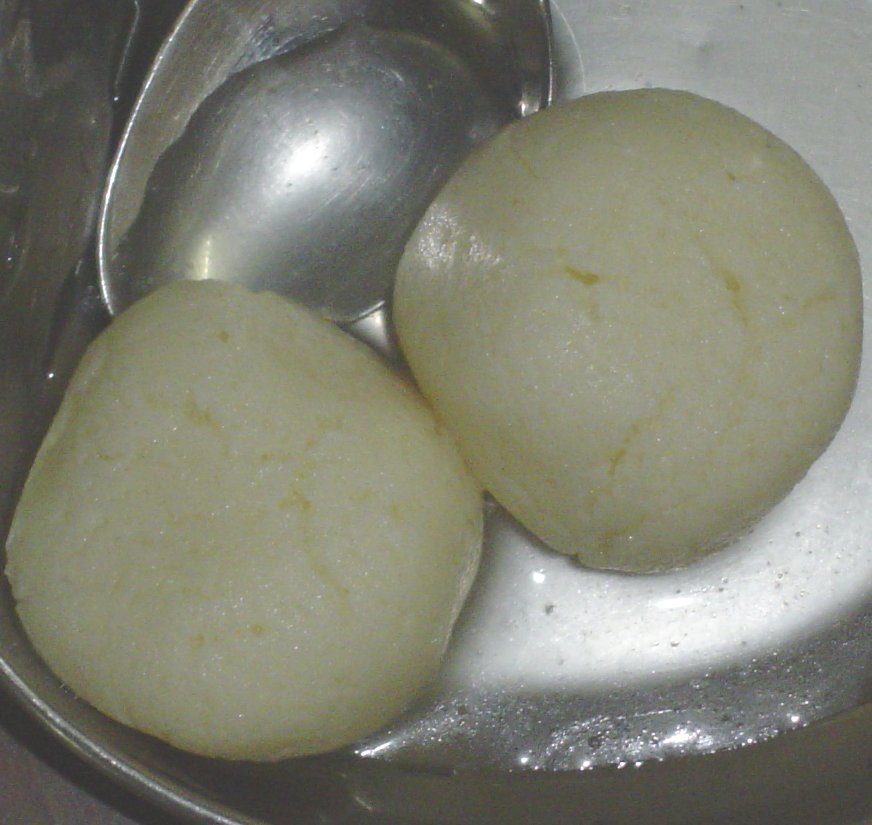
Conclusion
Bengali New Year is the day when Bengal's beauty could be seen. Everywhere Rabindra sangeet could be heard and people gathered on the road to enjoy themselves. Many young generations love to hang out with their friends and gathered near the cinema hall, parks and other market places. The restaurants are crowded with people. Children gathered in the amusement parks with their parents. Bengal once again lit up beautifully on this day. In addition, people fully enjoy themselves.
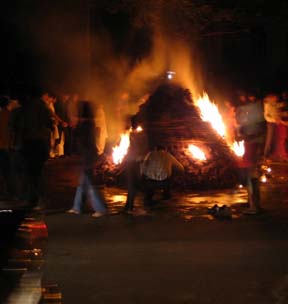 The festival of Holi is almost at our doorsteps only a few days away closely followed by Rang Panchami. Both these festivals are the most favorite occasions for the young and the young at hearts equally. Holi is celebrated in India and Nepal in the month of Falgun and it marks the beginning of sultry hot summer season. Everywhere in India, especially in the North, West and East it is celebrated with a lot of fervour and enthusiasm. The main celebrations of the festival involve playing in coloured water and spraying colours over friends and relatives. No one is spared. All the holi enthusiasts are seen coloured in a splashing rainbow of colours from red, pink, green, yellow, blue to silver and gold etc. Some are even seen painted in black. Everywhere you see, the atmosphere is full of bright and beautiful colours.
The festival of Holi is almost at our doorsteps only a few days away closely followed by Rang Panchami. Both these festivals are the most favorite occasions for the young and the young at hearts equally. Holi is celebrated in India and Nepal in the month of Falgun and it marks the beginning of sultry hot summer season. Everywhere in India, especially in the North, West and East it is celebrated with a lot of fervour and enthusiasm. The main celebrations of the festival involve playing in coloured water and spraying colours over friends and relatives. No one is spared. All the holi enthusiasts are seen coloured in a splashing rainbow of colours from red, pink, green, yellow, blue to silver and gold etc. Some are even seen painted in black. Everywhere you see, the atmosphere is full of bright and beautiful colours.
Harmful Effect of These Colours
But how safe are these colours? Apparently not very safe, as every year after the festival is over, many are reportedly injured by the toxic chemicals present in these colours, ranging from minor injuries such as skin rashes and allergies to major ones like loss of vision, deafness etc. In few incidents even deaths have been reported. Even the traditionally used pink powder that is called Gulal is not safe. Many people do not like to get wet and hence stick only to gulal but it contains silica and sometimes even asbestos both of which are very toxic and harmful. Due to metal in its composition, Gulal has been known to cause illnesses such as various skin diseases, asthma, and eye problems. Some colours that are very bright and flouroscent (commonly called factory colours) are mostly preferred by the young. But these colours are very hard to remove and cause mild-to-severe skin rashes and other problems. They also create a very foul odour and yet are favoured by many all in the spirit of Holi. Silver colours are also known to contain toxic chemicals and yet are preferred by many. This is irresponsible behaviour in my opinion. In spite of being knowledgable about their harmful effects on us physically as well on the environment, use of such colours is condemnable.
Why are we still indulging in these colours? Why not make our own colours from natural sources and try and make this Holi and Rang Panchami a safer one, safe for us as well as for the environment. We only need to look around and we will see so many alternative options for preparing safe colours.
Natural Methods of Preparing Colours
Mother Nature has been very generous and has blessed with abundant colours in various forms. There are many ways of preparing ecofriendly and safe colours from various leaves, flowers, roots etc. Here are some ways on how to get colours to play with this holi.
Green Colour: Natural green colour can be obtained by using Mehendi leaves, spinach, coriander and mint leaves. Dry mehendi leaves in shade and crush it to fine powder and mix it with chick pea flour(besan) and use this powder. Not just a great alternative to chemical colour, it will help improve your skin tone too. Alternatively you may boil fresh mehendi leaves in water and use the water which will give brownish to greenish tinge. For darker green colour grind fresh spinach or mint or coriander leaves and mix in water. This is a really safe and naturally beautifying for your skin too.
Yellow Colour: This is the time when you might still get fresh turmeric in the market which is the best way to get a lovely yellow colour. Bring home fresh turmeric, chop in fine pieces and soak in water for a few hours, then strain to get beautiful yellow colour that is not just safe but really good for your skin as well. Or if you do not find any fresh turmeric, just use the dried turmeric powder from your kitchen, either use the powder as it is or mix it with chick pea flour or in multani mitti, a type of clay used to prepare beautifying face packs. Alternatively, soaking dried marigold flowers in water for a few hours and then straining will also give you nice yellow colour. These flowers are available in India all through the year and you can save these flowers from the torans put up on the doors of your homes.
Red Colour: Pick some red hibiscus flowers and dry them in shade. Crush these flowers to fine powder and mix with flour or soak the powder in water to get nice red colour. Alternatively, saving pomegranate peels and boiling them in water will also give a dark red tinge. To get even darker and more beautiful tinge of red, just grate some beetroots and soak them in water for a couple of hours. Then squeeze and strain it to get lovely red colour.
Blue Colour: This is the flowering season for jacaranda trees which give beautiful blue, bell-shaped flowers. If you come across a jacaranda tree, you will find the ground beneath it covered with lovely blue flowers, pick these up and dry them. Then crush the flowers to a fine powder and use this to colour your friends blue.
Black Colour: To get black colour, boil dried amla fruits (Indian gooseberries) in an iron wok and keep them overnight in the boiled water. Next day, strain the liquid and add plenty of water to it which will be black in colour. Besides this, you can use 'hirda' or 'haritaki' (Terminalia chebula) in the same manner to get dark brown to black colour. Both these ingredients, amla and hirda are easily obtainable from shops that sell traditional herbs.
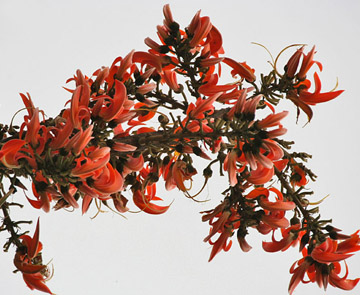 Orange Colour: To get orange colour, use the stocks of parijatak flowers, Nyctanthes arbor-tristis which is commonly called as Coral Jasmine. These are beautiful white flowers with bright coral stalks. The dried stalks of these flowers when soaked in water will give beautiful orange colour for your holi celebrations. The palas or palaash trees (Butea monosperma) that flower during this season all over India can also be used to make orange to saffron colour.
Orange Colour: To get orange colour, use the stocks of parijatak flowers, Nyctanthes arbor-tristis which is commonly called as Coral Jasmine. These are beautiful white flowers with bright coral stalks. The dried stalks of these flowers when soaked in water will give beautiful orange colour for your holi celebrations. The palas or palaash trees (Butea monosperma) that flower during this season all over India can also be used to make orange to saffron colour.
There are other things which can be used to prepare colours, such as raktachandan or red sandalwood which can be used to prepare reddish brown colour. Other herbal ingredients such as manjishta (Rubia cordifolia) and bark of the Khair tree (Acacia catechu) from which kattha (an ingredient to bring colour to betel leaf) is made, can be used to make brown colours. These are also available in most stores selling herbal medicines. You only need to keep an open mind and do a little research as well as take some efforts prepare these ecofriendly colours.
Being Sensitive Towards Environment
Celebrations are a part and parcel of our lives and are necessary to bring colour to our otherwise mundane routine. But while we are out enjoying ourselves, we must also spare a thought for those who are striving to save the environment and do our bit towards a safer and greener environment. We can contribute to this good cause by observing some of the following things:
This holi let us not cut down trees mindlessly to be burned down on the night of Holi bonfire. We can instead collect bits and pieces of old wooden furniture, coconut husks and shells, saw dust etc. There are some mischief mongers who throw plastic, thermocol stuff inside the bonfire which releases noxious fumes and foul odorous gases. Let us be extra vigilant and see to it that no one does such a thing. It is essential that we maintain the purity and sanctity of the rituals not just for the sake of performing rituals, but also to keep the environment safe and free from pollution. We can plant a tree each holi and nourish it to a healthy growth on this holi day.
Do not waste water. When more than half of Maharashtra and some other states in India are reeling with a severe famine, let us try to save water. I know that playing holi without water is something that is unimaginable, yet we have to make an effort. Instead of splashing buckets of water on others, let us stick to the pichkaris and spray water judiciously. Celebration or no celebration we have to remain conscious of civic sense hence stick to these resolutions. Try to save money that you would otherwise spend on colours and parties and give them to a drought-relief fund.
Do not create plastic trash by using small plastic bags filled with water and thrown on others. Similarly try to not use the water balloons as these too add to the plastic trash in subsequently large quantities.
These are only a few things that I felt were needed to change the way we celebrate holi. You can also think of something on similar lines and endeavour to make this year's holi a safe and enjoyable day for yourself and for others. So happy holi to you all and go ahead and
Colour Your Life Red!
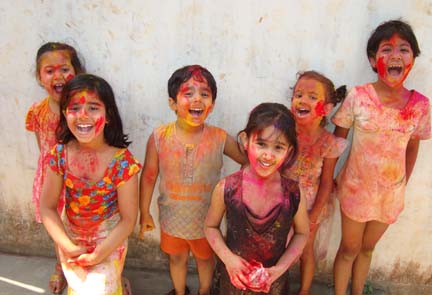
Image Source: All images from Wikimedia
 Relgions in India
Relgions in India
India is the cradle for diverse religions and a plethora of cultures. Owing to the vastness of the country and a multitude of religions, there will be a festival taking place every day of the year in some corner lof the country.The major religions of India ,Hinduism , Islam. Sikhism and Christianity all celebrate their festivals with religious fervour.
There are festivals unique to a particular place or a region. For example Onam is celebrated in Only Kerala.Ugadi is celebrated in Andhra pradesh only.
And the festivals pertaining to Islam. Sikhism and Christianity are celebrated through out the country irrespective of the regions they live in.
There are festivals which are universal.They are celebrated in the entire country. For example Diwali or Deepavali is celebrated from Kashmir to Kanyakumari. Similarly Dasara.
When it comes to festivals , the southern state of Andhra pradesh bears its own mark and own niche of its own with respect to religious fervour and gait.
Festivals
Festvals are not just occasions for revelry and merry making. Each festival has a story with a message.
Each festival has a tag of astrlogical significance.
Each festival is a reminder to renew relationships and bonds.
Each festival reminds the culture we are entwined with
Each festival offers a breather for a break from the hectic grind to recharge the spent energy for a fresh start with renewed vigor
Festivals, be it a 'Tourism Festival' or Local colourful festivals,are big revenue generators. Festivals and Fairs of India, always generated an awe in the in them domestic viewers well as foreign tourists.
Colourful Culture, Andhra
Andhra's cultural history is replete with examples of highest standards of excellence in the spheres of Art, Architecture, literature and its veritable cuisine.
Speciality of a Festival
A festival of any religion or region will reflect all the cultural aspects of that region in different sizes and proportions. In this respect Andhra iis not an exception. Every festival of Andhra will reflect a vivid picture of all the aspects of its culture.
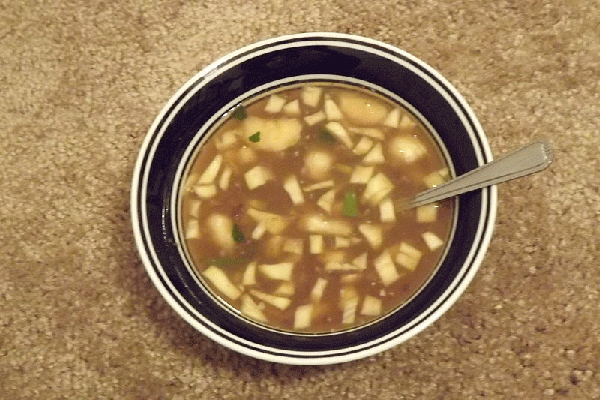 Ugadi
Ugadi
The festive season in Andhra Pradesh starts with UGADI. UGADI means, the beginning of an era or Epoch. Its also known as "Samvastaradi" , means beginning of the year.
This is the New year for Telugus, Kannadigas,Maharashtrians, Konkani. It falls on the day of " Chaitra Shuddha Padyami in the months between March and April.Its the belief of the people, whatever is done on this day, that will be reflected all through the year. Owing to this reason people especially business people start their ventures on this day as UGADI is considered as an auspicious day.
Panchanga Sravanam
The first item of the day of Ugadi is recitation of Panchangam or Almanac. Its a social gathhering where an elderly person of the communuty or a Purohit will read the Panchangam which is all about the general forecasting of the year that follows.
Message of Ugadi
Ugadi festival conveys the message that life is a mixture of several experiences like sadness , joy, anger, surprise, disgust etc. It should be taken as it comes to us. This message is conveyed through eating a preparation made of six tastes of life," Shadruchulu". The preparation is made of neem buds symbolizing sadness, Jaggery and ripe bananas symbolizing happiness,Green chillies symbolizing anger,Salt signifying fear,sour tamarind juice symbolizing disgust and green mango symbolizing surprise.
Bobbatlu
Bobbatlu is a delicacy specially made for the occasion of Ugadi. Its a stuffed Parotha like thing. But the paste made of jaggery and gram is stuffed into the parotha.
Makara Sankranti
It comes in the month of January. Its a harvest festival and marks the beginning of the harvest season and ending of north east monsoon of South India. When the Sun moves from one Zodiac sign to another that moment is called Sankranti. Here the Sun moves in to capricorn , which is called Makar, the occasion is called Makara Sankranti.Hindu festivals will not occur on a fixed day every year. But Sankranti is an exception. It falls on the same day January 14 or Januaryn15 if its a leap year.
Sankranti marks the ending of the winter season and the beginning of a new harvest season.
Different Names- One festival
Though Sankranti is celebrated all over India, it's known with different names in different states and regions. Here are the names Of Sankranti as known in different parts of India
In the state of Gujrat and Rajasthan Sankranti is known as Uttarayan.
In Haryana, Himachal Pradesh and Punjab Makar Sankranti is known as Maghi.
In Punjab, its known as Lohri.
In the state of Tamilnadu, its known as Pongal.
In Uttar Pradesh, its known as Khichidi.
In the Assam valley Makar Sankranti is known as Bhogali Bihu.
Some Legends
Shani the Son of the Sun god is the lord of the Makar Rasi. It's said the Sun God visits Shani , his son and stays for a month there.Owing to this reason Makar Sankranti has been given a special importance in the Hindu Puranas. It was on this day, Lord Vishnu ended the demons annihilating them.The bodies of the killed demons were buried under Mandara Parvata. Hence this occasion has gained importance as the ultimate trumph of good over evi. On this very day of Sankranti Bhishma decided to leave his mortal remains. He was blessed with the power of dying at his own will. This power is known as "Ichcha Mrityu."
Rituals and festivals connected with Makar Sankrnti.
In GujratSankranti is celebrted with pomp and splendour through a major and colourful event of Kite flying. Kite flying implies ba symbolic reaching of the Sun God.
In Andhra Pradessh, Sankranti is marked by both kite flying and cock fights. Many of the devotees take a dip in the sea known as "Pavitra Snan" or the holy dip. Many people take bath in Ganga sagar, where ganga merges with Bay of Bengal.
Its a bit different in Andhra Pradesh
Andhra Pradesh celebrates Makar Sankranti for 4 days. Each day with a different name.
The first day is known as Bhogi
The second day is known as "Pedda Panduga" or the big festival
The third day is known as Kanuma
The fourth day is known as Mukkanuma
On the first day Bhogi, all old things and unused things like clothes, broken or unused furniture is gathered and made a big Bonfire in the middle of the streets nearby in the morning. This ritual of burning the old things in the fire is symbolic of leaving and discarding all the badness in the humans and putting an end to bad things.
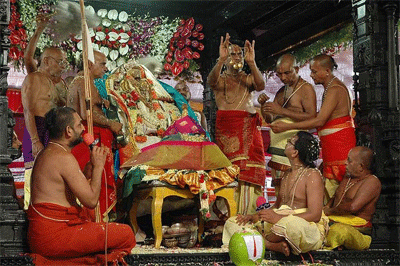 Rama Navami
Rama Navami
The marriage cerenony of Rama and Sita is celebrated every year in Bhadrachalam during March-April. The marriage is performed between the statues of Rama and Sita with all the pomp and splendour anidst the chantings of Vedic hymns and the auspcious music known as 'MangalaVadyam." The wedding event is attended by thousands of the general public as well as the chiefMinister of AndhraPradesh and its cabinet members.
Celebrations of Rama Navami are dedicated to Rama for remembering him as the most supreme ruler whose aim was only "Praja Kalyanam" or the wefare of his subjects. Due to this reason Rama's regime has become famous as the "Rama Rajjyam" or the regime of Rama as the synonym for the "Best Rule.' Rama Rajya spells a reign of Peace and prosperity with exalted standards of high moral values.
Sri Rama Navami festivities begin with the prayer of the Surya Deva, the Sun god on the early hours of the morning.
Dasara
Also known as Vijaya Dasami or Navaratri is another important festival of Andhra Pradesh. Dasara is celebrated for 10 days signifying as a mark of victory of Good over evil. On this day. Mahishasura a demon was killed by the shakti incarnation Durga. Owing to this reason Goddess Durga has become famous with the name "Mahishasura Mardhini",the annhilator of the demon Mahishasura.
Goddess Durga is worshiped in different forms on all the days of celebrations of Navaratri. On the last day, Durga is worshipped as Mahishasura Mardhini.
Dasara celebrations are performed in a most glittering way in Kanaka Durga trmple in Vijatawada atop a hill.
Deepavali
The festival of lights is celebrayed as a symbol of triumph of good over evil. On this day, the business community wraps up its records and start new account books. Some celebrate it as lakshmi puja, the worship of Goddess of prosperity.Like all other festivals new clothes are worn by both youngsters and elders. This colourful day is marked with burning of crackers.
 Vinayaka Chaviti
Vinayaka Chaviti
Also known as Ganesh Chaturti which comes in the monrth of "Bhadrapadam". Vinayaka is well known as the 'Obstacle remover'.Owing to this reason, people believe that performing Vinayaka puja before starting a job will lead to smooth movement sans problems.
Environmental concerns
The Vinayaka idols are made of clay once, But Plaster of Paris has come into vogue of late, bacause of its cost effectiveness and easy mouldability quality. But Plaster of Paris is non- biodegradable and insoluble in water. In addition to this, the chemicals in the colours used for painting the Ganesha idols lke cadmium and Mercury cause water pollution during immersion of the idols of Ganesha.
Now the stress is on making the idols small with natural clay.Or making a permanent image made of Stone or brass and making the immersion ceremony symbolic.
History
Since the times of Shivaji, the founder of Maratha empire, celebrating Ganesh puja as a public function was in practice. Ganesha was the family deity of the Peshwas. It was under their patronage till 1818. Now Ganesha lost the elite patronage. Private patronage has come into vogue. After many years, the great freedom fighter and social reformer Lokamanya Bal Gangadhar Tilak revived by making the domestic function in to a public function.
Batukamma
This is an exclusuve festival observed by the women of Telengana region. Batukamma is a festival that coincides with Navaratri and is celebrated for nine days. It starts on Mahalaya and concludes two days before Dasara.The final day of the Batukamma Panduga is known as "Pedda Batukamma" or "Saddula Batukamma."
What is Batukamma
Batukamma is a flower arrangement in the form of a cone in 7 layers one above the other. The flowers are seasonal flowers. Women wear colourful Pattu Saris and jewelry for this occasion. On the first five days, Batyukamma is prepared wth cow dung and kept in front of the house. Around the Batukammas beautiful "Muggus" or Rangoli are drawn with rice powder.
Its all singing and dancing
As Batukamma festival or Batukamma Pandaga as called in Telugu is a woman centered festival, all the women in the localty gather in the evening with their beautifully made Batukammas and keei them in a central place. Women form a circle arond the batukannas and start singing and clapping wiith a precise rhythm and moving in a circular pattern. Sll the songs belong to the folk genre.
After the song and dance session women with their Batukammas go to a nearby pond or a lake and leave Batukammas afloat in the water The ninth and last day of the festival is known as Saddula Batukamma and on this day, it will be a treat to the eye to watch all the Batukammas floating on the waters of lakes and ponds.
Bonalu
Its a festival of the goddess Maha Kali, observed in Telengana regions of Andhra Pradesh. Bonalu is celebrated in the month of Ashadam in July/ August. Special poojas are performed to the goddess Yellamma. Bonalu is also known as Thanks givimg function to the goddess for bestowing boons on her devotees.The other name with which Bonalu festival is known as is"Mahankali Jatra". During this period one cannot miss processions of women walking towards temples of Kali with pots piled over their heads. The pots arer called 'Bonalu." these are filled with water with neem leaves and turmeric powder .These are topped with rice in a copper pot( or earthen pot). Of course with a lighted oil lamp.
Earlier there was a practice of offering animal sacrifices. Presently this practice has given way to just rice and white gourd are offerd to Mahankali goddess.
The State of Andhra Pradesh generates a good amount of Revenue through its rich cultural heritage, Historical places and a bounty of natural beauty. It also orgnizes a number of "Tourism Festivals." Here are some prominent festivals.
Tourism Festivals
- International Kite Festval at Hyderabad
- Kakatiya Festival at Warangal
- All India Arts and Crafts festival at Shilparamam, Hyderabad
- Deccan Festival /Hyderabad Festival at Qutb Shahi Tombs, Hyderabad.
- Lumbini Festival at Hyderabad /Nagarjuna Sagar
- Rayalaseema Food and Dance Festival at Tirupati.
- The Vijayanagara Festival at Chandragiri
- All India Girijan Festival and Artist's Camp at Araku and Borra Caves.
- Visakha Utsav and Rushikonda Beach Festival at Visakhapatnam.
More Articles …
Subcategories
Festivals
The category focusses on festivals followed at different places of the world.
Page 384 of 391
